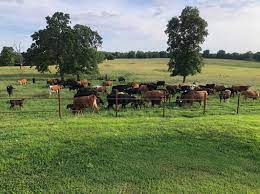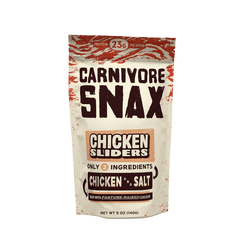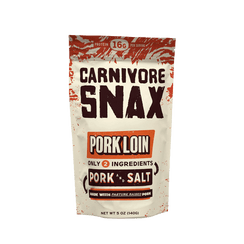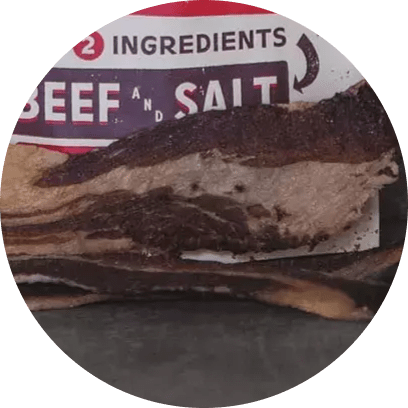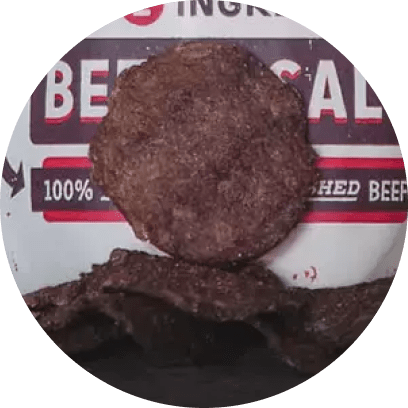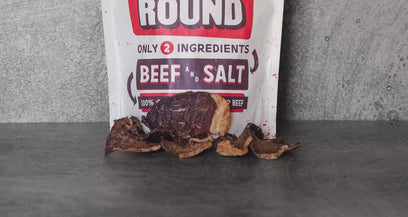THE CARNIVORE DIET BENEFITS




As you discover just how powerful the implications of regenerative farming are, you’ll start to view the food supply chain through a whole new lens. No longer are you willing to just buy anything at the grocery store or online. Your standards have raised - and for good reason.
But, there’s a common question we see asked in this community - is regenerative farming organic? Surely it must be, as organic farming and regenerative farming share so many similarities. Or, does the Venn diagram between the two practices just share a few commonalities?
Today, we’re going to take a detailed look at the practices that go into both methods of farming - regenerative and organic. We’ll help you gain a better understanding of the difference between organic and regenerative agriculture by the time you finish reading this article.
Then, we’ll empower you with actionable next steps if you want to support regenerative farming while gaining access to the best low carb snacks on the market. Let’s not waste any more time.
Is Regenerative Farming Organic?
The question of whether or not regenerative farming is organic or not isn’t as simple as “yes” or “no”. As you can imagine, the answer is not one size fits all.
Some regenerative farms are also considered organic - that much is true. Meanwhile, though, other farms implement regenerative farming practices yet fail to earn the full classification of “organic”.
To set the stage for the rest of this conversation, let’s begin by fully explaining regenerative farming.
What Exactly is Regenerative Farming?
First things first - what is regenerative agriculture? This is a holistic approach to agriculture that focuses on restoring and improving soil health, increasing biodiversity, enhancing water cycles, and promoting overall ecosystem resilience.
Or, in simpler terms, regenerative farming seeks to get closer to how our ancestors cultivated foods in a more natural, sustainable way. So, how does regenerative agriculture work? Here are just a few of the practices farmers employ under this umbrella of agriculture:
- No-till or minimum-till farming: Reducing soil disturbance helps maintain soil structure and preserves the habitat of beneficial soil organisms, which play a crucial role in nutrient cycling and soil fertility.
- Cover cropping: Planting cover crops is a practice that protects the soil from erosion, suppresses weeds, and improves soil fertility by fixing atmospheric nitrogen and adding organic matter to the soil. This is something you can learn more about in our article on how regenerative agriculture sequesters carbon.
- Crop rotation: Rotating crops reduces the risk of soil-borne diseases and pest infestations, while also helping to maintain soil fertility and structure. This eliminates the need for toxic, harmful pesticides and fungicides.
- Compost and organic matter: Adding compost and other organic matter to the soil helps improve its structure, fertility, and water-holding capacity. This also eliminates the need for harsh commercial fertilizers that alter the structure and taste of your food, while harming the lands it’s grown in.
- Agroforestry and silvopasture: Integrating trees and shrubs into agricultural systems provides multiple benefits, including carbon sequestration, improved biodiversity, and additional income sources for farmers.
- Holistic grazing management: Managing livestock to mimic natural grazing patterns helps regenerate grasslands, build soil organic matter, and improve water retention. Plus, it makes for happier livestock who live a more natural life!
Why is regenerative agriculture important, though? Simple. By adopting a diverse range of farming practices, regenerative agriculture aims to create a sustainable, productive, and environmentally-friendly food system.
The end result? Consumers enjoy tastier, healthier food (at lower costs) while the farmers that bring these foods to life enjoy a healthier, happier lifestyle. Meanwhile, we’re restoring and preserving our lands for future generations to enjoy.
Sounds great…but does regenerative agriculture really work? It sure does - we’ve already witnessed the positive effects of this type of farming at play. In order to really reap the benefits it has to offer, though, we need widespread adoption of this method.
We’ll talk more about that later. First - let’s progress this conversation by discussing what constitutes organic farming. That way, you’ll be able to identify where they’re similar, and more importantly, where they differ.
What Constitutes Organic Farming?
Organic farming is another popular approach to agriculture that places a strong emphasis on sustainability, environmental protection, and the overall health of both the ecosystem and the consumers who enjoy the produce.
At its core, organic farming is about nurturing the soil, promoting biodiversity, and avoiding the use of synthetic chemicals such as pesticides, herbicides, and artificial fertilizers. Instead, organic farmers rely on natural processes and inputs to create a vibrant and thriving farming ecosystem.
In this way, it’s quite similar to regenerative agriculture. Here are some of the main components of organic farming:
- Soil fertility: Organic farmers focus on building and maintaining healthy soil by using compost, green manures, and crop rotations to add essential nutrients and organic matter. This not only improves soil structure and water-holding capacity but also supports the growth of beneficial soil organisms that play a key role in nutrient cycling.
- Pest and disease management: Organic farming aims to prevent and manage pests and diseases through proactive measures such as crop rotations, intercropping, and the introduction of natural predators. When necessary, organic farmers use only approved natural pesticides and treatments to protect their crops.
- GMO-free: Organic farming strictly prohibits the use of genetically modified organisms (GMOs), as they do not align with the principles of natural and sustainable agriculture.
- Animal welfare: Organic livestock production prioritizes the well-being of animals, providing them with access to fresh air, sunlight, and opportunities to engage in natural behaviors. Organic farmers also avoid the use of antibiotics and hormones, opting for natural alternatives and preventive measures to maintain animal health.
- Certification and regulation: Organic farming is subject to strict certification and regulation to ensure that products meet the high standards expected by consumers. This involves regular inspections, audits, and adherence to established organic farming guidelines.
Now, you’re likely still wondering - is regenerative farming organic? And if not, what is the difference between organic and regenerative agriculture? Let’s take a look…
So, is Regenerative Farming Organic? If Not, What is the Difference Between Organic and Regenerative Agriculture?
There’s no question that regenerative farming and organic farming share common goals - and even some of the very same practices. So - is regenerative farming organic? No. These approaches to farming are not identical.
Regenerative farming goes a step further in its focus on improving soil health and rebuilding ecosystems, whereas organic farming primarily aims to avoid synthetic inputs and maintain a more natural farming process. Here's where the differences between each method lie:
- Scope: Organic farming is more focused on the inputs and practices used in crop and livestock production, such as avoiding synthetic chemicals and GMOs. In contrast, regenerative farming takes a broader approach, concentrating on restoring and revitalizing the entire ecosystem, including soil, water, and carbon sequestration.
- Carbon sequestration: A key aspect of regenerative farming is its emphasis on capturing and storing carbon in the soil. This process helps preserve our lands by reducing greenhouse gas emissions. While organic farming can contribute to carbon sequestration, it is not a primary focus of the method.
- Soil health: While both approaches prioritize soil health, regenerative farming places a stronger emphasis on improving soil structure, fertility, and biological activity. Regenerative practices like no-till or minimal tillage, cover cropping, and diversified crop rotations are designed to maximize the potential for soil regeneration, going beyond the organic farming requirements.
- Certification and regulation: Organic farming is regulated and certified by governing bodies to ensure adherence to established guidelines. Regenerative farming, on the other hand, does not currently have a universally recognized certification system. However, some organizations and initiatives, like the Regenerative Organic Certification, are working to create a certification process that combines regenerative and organic practices.
The key takeaway here should be that regenerative farming can be considered a more comprehensive approach to sustainable agriculture that goes beyond the restrictions of organic farming. However, not all regenerative farms are necessarily organic, as they may not meet the specific criteria and certification requirements for organic farming.
Think about it like this. Regenerative farmers are less focused on crossing off boxes that earn them certification and regulation, and more concerned with doing what is best for the end consumer, the lands, and the workers on their farm. By prioritizing the wellbeing of these individual components - while focusing on biodiversity and ecosystem resilience - the rest falls into place.
The Benefits (and Challenges) of Combining Regenerative Agriculture and Organic Farming Practices
As you can imagine, there are benefits to combining regenerative agriculture and organic farming practices to create the most sustainable, well-rounded food ecosystem possible. These practices can work together synergistically to enhance the livelihoods of farmers and consumers alike while preserving our lands for future generations.
Benefits of Merging Regenerative and Organic Farming
- Enhanced Soil Health: Both regenerative and organic farming focus on improving soil health by increasing organic matter, fostering beneficial microbial activity, and reducing soil erosion. This results in improved soil structure, water retention, and fertility.
- Reduced Chemical Use: Organic farming prohibits the use of synthetic fertilizers, pesticides, and herbicides, while regenerative agriculture encourages the use of natural alternatives. This reduces the environmental impact of agriculture and minimizes the risk of chemical residues in food.
- Increased Biodiversity: Combining regenerative and organic practices helps maintain and enhance biodiversity both above and below the ground. This supports a healthy ecosystem, which in turn promotes natural pest control, pollination, and nutrient cycling.
- Carbon Sequestration: Regenerative agriculture practices, such as cover cropping, no-till farming, and agroforestry, help capture and store carbon in the soil. Combined with organic farming's reduced reliance on fossil fuel-based inputs, this contributes to the restoration of our lands.
- Resilient Farming Systems: The integration of regenerative and organic farming practices builds more resilient agricultural systems capable of withstanding extreme weather events, pests, and diseases.
- Improved Nutritional Quality: Research suggests that organically grown produce often has higher nutrient levels. Combined with regenerative practices that focus on soil health, this can lead to even more nutrient-dense food for consumers
However, as you’ll discover below, there are also some challenges to merging these practices into one single farm.
Challenges of Merging Regenerative and Organic Farming
- Higher Costs: Transitioning to regenerative and organic practices often requires upfront investments in new equipment, training, and infrastructure. Additionally, organic certification can be expensive and time-consuming.
- Learning Curve: Adopting new practices and techniques can be challenging for farmers who are used to conventional agriculture. They may need additional training and resources to successfully implement these methods.
- Yield Variability: In the short term, some farmers may experience reduced yields as their soil and ecosystems adjust to the new practices. Over time, however, yields often stabilize and may even increase.
- Market Access and Demand: While demand for regenerative and organic products is growing, it may still be challenging for farmers to find buyers willing to pay a premium for their products
- Policy and Regulatory Barriers: Existing agricultural policies and regulations may not always support regenerative and organic farming practices, making it more difficult for farmers to access incentives or resources to help them transition
Now - that’s not to say that the benefits don’t outweigh the challenges. They do! The only question is, how do we get mass support for these practices? We’ll offer our opinion on the matter below…
How Can We Work Towards Mass Adoption of Organic and Regenerative Farming Methods?
The fact that you’re here reading this guide is a sign that more and more individuals are aware of the benefits of - and advocating for - the mass adoption of regenerative and organic farming methods. The hard part is reaching the key parties necessary to make lasting, impactful change.
With that said, there are actionable steps you can take right now to do your part. And, they’re much easier than you may have assumed:
- Support local, organic, and regenerative farmers: Purchase products from local farmers who practice organic and regenerative farming techniques, as well as food brands that have adopted these practices, such as Carnivore Snax. Supporting these businesses directly contributes to the growth of sustainable farming.
- Shop with brands that support these methods: If you can’t support these farmers directly, you can still put your money where your mouth is by shopping with brands that do - like Carnivore Snax. Our delicious carnivore crisps are sourced from the most elite, ethical regenerative farms in the country. Our meat chip collection has something for everyone: including ribeye chips, steak chips, lamb chips, beef chips, brisket chips, chicken chips, and even pork chips.
- Advocate for change: Contact your local representatives and encourage them to support policies and initiatives promoting organic and regenerative farming practices, such as funding for research, educational programs, and financial incentives for farmers.
- Educate yourself and others: Learn about the benefits of organic and regenerative farming practices, and share this information with friends, family, and your social network. Spreading awareness can inspire others to make informed choices and support these practices.
We have a complete guide on how to support regenerative agriculture if you’d like to learn more. For now, though, it’s time to bring this conversation to a close.
Final Thoughts on the Difference Between Organic and Regenerative Agriculture
There you have it - the difference between organic and regenerative agriculture explained. While these practices share many similarities, they are also quite different. Regenerative agriculture takes things a step further than organic farming, which is why it’s so important that we all take steps toward making this the norm here in the US food supply chain.
So, with that said, you can do your part by supporting companies that put their money where their mouths are - like we do here at Carnivore Snax. You can get your carnivore crisps today to satisfy your cravings while enjoying the healthiest snack possible - sourced 100% through regenerative farms!









